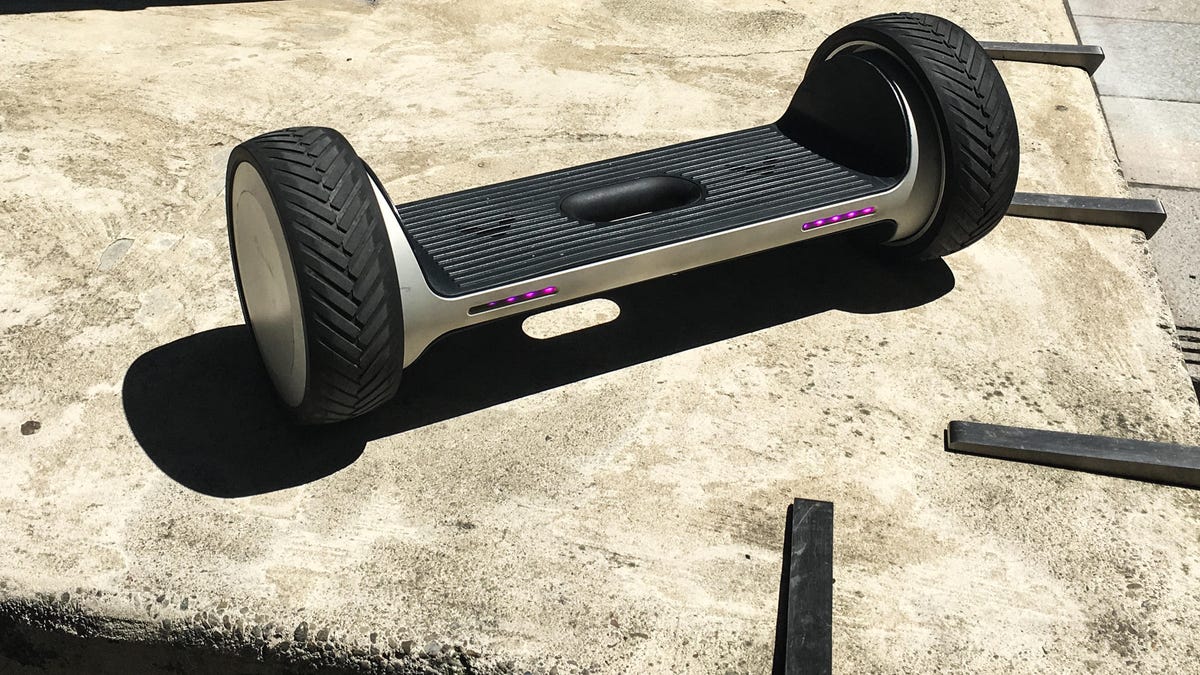Radical's hoverboard for adults lets this beginner ride easy
Startup Radical seeks to reinvigorate the hoverboard with its Moov board.
Hoverboards may seem like an explosive toy of the past, but startup company Radical bets that all three of those points are wrong. Radical launched its Moov hoverboard on Kickstarter, promising an effortless last-mile option for commuters or just a novel way of getting around.
And unlike the multitude of imported hoverboards banned by the government, Radical designed and priced Moov for adults.
Radical co-founder Evan Williams visited the CNET office in San Francisco with a prototype of the Moov hoverboard which, incidentally, proved to be my first time riding one of these devices. If you aren't already aware, a hoverboard is a plank with motorized wheels at either end, meant to be ridden perpendicularly to how you would ride a skateboard.
Williams gave me a hand as I planted my feet on the Moov, following his advice to put my feet as close to the wheels as possible. The "board" connecting the two wheels sits below the hub axis, so it's unlikely to flip over. The whole thing feels sturdier than my shaky legs as I try to balance.
It only takes me, a complete novice, a couple of minutes to get comfortable riding the Moov.
I take my first tentative run by tipping my feet forward, and the Moov, well, moves. It proves tough at first as I inadvertently turn, zig-zagging down the pavement in front of the general public.
As with earlier hoverboards, the Moov turns when the rider applies forward foot pressure to one side of the board. Unlike those hoverboards, which used a twist mechanism in the middle of the board, Moov uses torque sensors in its chassis that detect pressure on either side of the rigid board. That lets the Moov get away with a flat board uninterrupted by a central pivot, and, as Williams points out, replaceable plastic decks for style changes.
Although I'm shaky on my first few runs on the Moov, I manage to dismount without face-planting. And in just a couple of minutes, I'm super smooth, controlling speed and doing figure eights intentionally. I've got this. Then Williams jumps on the Moov and makes my efforts look like a toddler taking its first steps.
Williams also demonstrates some of the Moov's other tricks. He set it on end and it goes into Disco mode, running its integrated LED lights through a rainbow of colors while the board section spins around. That will be fun at parties, but more importantly, the integrated lights enhance safety when riding at dusk or night.
Moov connects to a control app through Bluetooth, and Williams tells me that he can adjust the sensitivity of its torque sensors, customizing it for different rider experience levels.
It runs up to 15 mph thanks to its dual in-wheel motors, and its integrated lithium-ion battery pack give it approximately 12 miles of range. I can't imagine wanting to ride a hoverboard at any greater speeds, or over a greater distance. The Moov doesn't have a suspension and the hard rubber tires can only rely on their size to negotiate rough pavement.
24 pounds on the spec sheet sounds like a lot to carry around, but the Moov feels light to me when I pick it up by its handhold. As a last-mile transportation option, it would be easy to carry onto a bus or train.
In Disco mode, the Moov spins on its wheel, cycling integrated LED lights through a rainbow of colors.
As for safety, Williams tells me that UL, the company that comes up with safety certifications for most electronics in the US, came up with a certification specifically for hoverboards. He says that Radical is aiming for that certification with the production version of Moov. I'm more concerned about going face-forward to the pavement than having the thing catch fire.
Radical already met its goal for Moov's Kickstarter campaign, but backer slots are still open, which offer a significant discount on the price, with delivery estimated for this December.
At $1,499, Moov's retail price isn't cheap, and clearly sets it into the adult personal transportation segment rather than a toy for the kids. As an example of competition in this segment, Segway offers its miniPro, a cheaper but less portable hoverboard, distinguished by a well-known brand.


